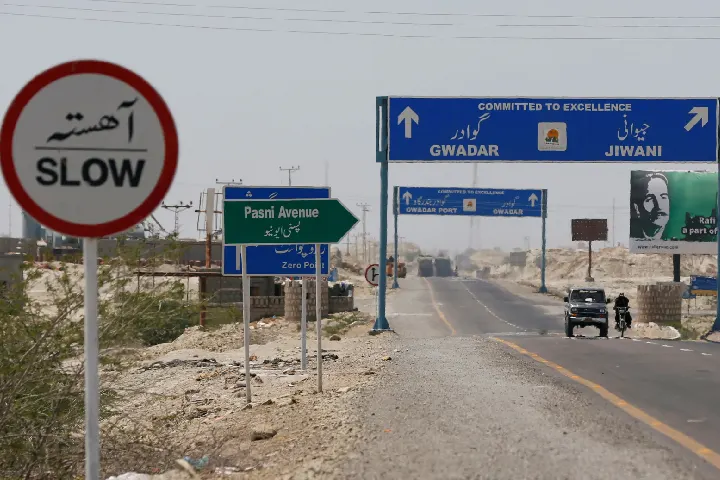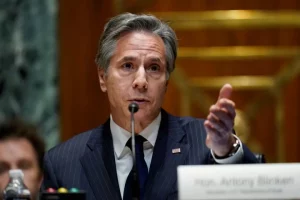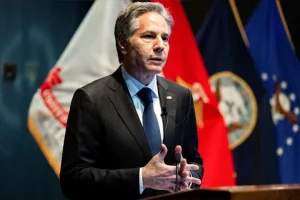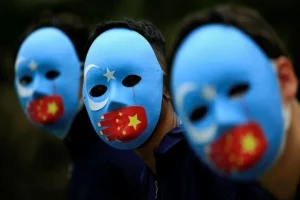By briskly appointing an ambassador to Kabul, China has emitted that it is planning to reconfigure its ambitious Belt and Road Initiative projects. There are signals that China may focus more on the Afghanistan-Iran leg of its projects as “delays” are plaguing the China-Pakistan Economic Corridor (CPEC) due to a dysfunctional Pakistani government.
On Wednesday, the Taliban-led foreign ministry said that Prime Minister Mohammad Hassan Akhund had accepted Ambassador Zhao Xing’s credentials at a ceremony in the Afghan capital.
Beijing did not immediately signal if Zhao’s appointment could lead to a formal recognition of the Taliban government. In any case, it is unlikely that China would go that far, as there appears to be a consensus among various external stakeholders that Taliban should first form an inclusive government before formal recognition can be considered.
#China becomes the first country to appoint a fulltime Ambassador to Afghanistan since #Taliban Takeover in August 15, 2021. The Islamic Emirate of #Afghanistan Taliban’s Prime Minister, Mullah Mohammad Hassan Akhund, accepted the credentials of Zhao Xing. pic.twitter.com/LbjqPrpjtI
— Ghulam Abbas Shah (@ghulamabbasshah) September 13, 2023
China in Afghanistan
No government has formally recognised the Taliban since they seized power from a US-backed government in August 2021 when all American-led NATO troops withdrew after nearly 20 years of involvement in the Afghan war.
Only Pakistan and the European Union have their top diplomats in Kabul in the capacity of charge d’affaires. Overall, India, Iran, Pakistan, Qatar, Russia, the UAE and Uzbekistan are among the countries that have kept or reopened their diplomatic missions in Afghanistan since the Taliban takeover.
Ahead of appointing its ambassador, Beijing has taken steps to help the Taliban stabilise the Afghan economy and deal with a dire humanitarian crisis. Western nations suspended all financial aid and imposed economic sanctions on the new Kabul rulers after departing the country. Chinese investors have signed significant agreements with Kabul in the Afghan mining and oil sectors.
Analysts say China’s security concerns are driving its increased diplomatic engagement with the Taliban to prevent the conflict-torn country from sliding into chaos again.
“China is interested in Afghanistan’s security and the potential development of terror groups in its immediate neighborhood,” said Torek Farhadi, a senior regional analyst and former Afghan official. “This is why next to the new ambassador, the Chinese military attaché is seated,” he said, referring to the photo the Taliban official released after the meeting with Zhao.
But senior Pakistani journalist Haroon Rashid says that the Chinese are getting tired of Pakistani lethargy in supporting timely completion of CPEC projects. “Chinese have realised that if they get late on CPEC projects and in the meanwhile the India-Middle East-Europe project gets on track, they will miss the bus. They are ready to take the risk with the Taliban and then convince Iran to take their BRI forward,” said Rashid.
He added that Chinese have not interacted with the Interim Pakistan government significantly since it came to power and it says a lot about their trust on the present Pakistani regime. “Plus, Arab countries like Saudi, UAE and Qatar have already bid for several Pakistani properties like major airports and other installations. We know that Americans are in full cahoots with these Arab nations. It is also driving Chinese away from Pakistani rulers,” he said.
Failed CPEC : The snail-paced progress of CPEC projects is like a slow dance btn Pakistan’s economic crisis&China’s economic snooze button. With Pakistan being a financial black hole, it’s no wonder there are doubts about China getting any return on their investments. #FailedCPEC pic.twitter.com/ek9Le1BxUG
— Abdul Kashmiri (@MartinRonney) June 20, 2023
Afghanistan, unlike Pakistan, is China’s neighbour and thus it will be more convenient for China to manage any future project.
Meanwhile, some analysts also say that once the new Pakistani government will assume charge, it will work to implement the agreement to extend the China-Pakistan Economic Corridor (CPEC) to Afghanistan.
The lack of security in Pakistan and the resurgence of TTP (Tehreek-e-Taliban Pakistan) and other terrorist organisations in the region have prevented any movement for the CPEC being linked to Afghanistan.
Current circumstances should lead Afghans to consider alternative trade methods. In order to meet its needs, Afghanistan should import goods from Central Asia. Builds a cold storage facility to keep fresh fruit longer. Chabahar’s importance: Alternative to Pakistani ports. pic.twitter.com/Ubxur3ZWsQ
— Qadeer Khan Mutfi🇦🇫 (@AMutfi) September 14, 2023
China and Iran Partnership
More than China, the India-Middle East-Europe project has evoked sharp reactions in Iran. The Iranian media has described it as a US plot to get Israel recognized by Arabs and sideline Iran, China and Russia in the West Asian scheme of things. “The India-Middle East-Europe corridor will compete with China’s BRI project. The goal of this project is to connect India’s ports with the United Arab Emirates, Saudi Arabia, etc. by developing a large-scale rail network and then get access to Israel and Europe from there.
Proposed India-Middle East-Europe trade corridor explained in this video. pic.twitter.com/ndshkZOji0
— Vice Admiral Arun Kumar Singh (@subnut) September 11, 2023
This is not only limited to economic matters, but by standing with Saudi Arabia and Iran, China has given a clear message that now its political position has also become strong in this region and the UAE and Saudi Arabia have also joined BRICS, which also includes India, China and Russia. America cannot afford such a situation,” wrote Tehran Times in one of its edit pieces.
Tehran Times compared US designs with that of the British Empire that following the fall of the Ottoman Empire shadowed the Arab region.
Persian newspaper Sobh-e-No commented that the planned project is to stymie the importance of Iran which is the heart of trade in the region. “US President Joe Biden is trying to achieve his three strategic goals with one plan; it means competing with China, bypassing Iran, and undermining its economic interests, as well as bringing Saudi Arabia closer to the Zionist regime of Israel. Some G20 countries, such as Saudi Arabia, while claiming diplomatic efforts to get closer to Iran, are promoting projects to bypass Iran,” it wrote.
A Delhi-based senior analyst told India narrative that the announcement of the economic corridor has generated intense angst in Iran and that no official has made any comment on it. He also admitted that once any progress will be made on the route, Tehran will provide more leeway to China that already plans to expedite its plethora of projects in the country.
According to other Persian newspapers like Kayhan, and news agencies Tasnim and ISNA, Iran should expedite projects with China and Russia and open alternative routes using the Suez Canal before Arabs succumb to US pressure to sink deep into the economic corridor.
One of the major Chinese projects in Iran is development of the East-West International Transport Corridor in the Maku Free Zone. “It has the capacity to create a framework for a powerful communication network from China to the Baltic and Scandinavian countries, and considering its geographical location, the Maku Free Zone actually plays the role of a four-way land in this route and in China’s One Road-One Belt Initiative (BRI),” said Hossein Garousi, head of the Maku Free Zone Organisation.
Export from Maku Free Zone stands at nearly $420m since Mar. 2021https://t.co/h2PNotbWyVhttps://t.co/R78qCyp5tr#news #gbn24 #news24 #news_today #breaking_news #world #business #sport #entertainment #tech pic.twitter.com/YxDaFVsxV3
— GBN24 (@GBN24_online) August 30, 2023
Iran’s ties with China — part of a broader shift toward the East — have strengthened particularly since the United States withdrew from the nuclear deal and reimposed sanctions on Tehran in 2018. China reportedly continued importing Iranian oil despite US sanctions. In 2021, the two countries signed a 25-year strategic agreement to strengthen economic and security cooperation.
“Iran is very important as a source of energy, but also as a provider of security in the region. In the future, Iran and China are going to be very closely interdependent,” Nasser Hadian, a professor of political science at the University of Tehran told the Iran Primer on the possibility of Iran-China relations getting a whip of the wind.
One more project that may grab attention in both Chinese and Iranian planning is the development and use of Chabahar port.
Located on the edge of the Indian Ocean, it is the only deep-sea port in Iran with direct ocean access. Its geographic proximity to countries such as Afghanistan, Pakistan, and India, as well as its status as a key transit center on the burgeoning International North-South Transport Corridor, gives it the potential to develop into one of the most important commercial hubs in the region.
Chabahar is also one of the few places in Iran that is exempt from US sanctions, which significantly simplifies trade procedures with other countries.
What I find most interesting about this proposed GLOC is that it abandons the north south corridor through Iran, for which India invested in Chabahar intending to connect it to the Caspian, a route co-planned with Russia. I’m surprised no one has picked this up. https://t.co/LY4B0QUj8Z
— (((Christine Fair))) (@CChristineFair) September 11, 2023
With India and China competing to invest in this harbor, Iran is trying to play the two rivals off each other to boost its own international standing. India and China have their own plans for Chabahar and bilateral relations with Iran. While the scope of Sino-Iranian interaction in Chabahar port remains limited at this point, evidence of intensified Chinese activity with Iran suggests that it is attempting to compete with India for greater influence in the region.
China launches direct shipping line to Iran’s Chabahar port.
The first container ship departing from China docked at Iran’s key port of Chabahar on Saturday. pic.twitter.com/yPeiblQNAi— IranMilitaryNews (@IranMilitaryNet) January 11, 2023
However, a Professor of Tehran University’s Academy of International Relations told India Narrative that it would not be in Iran’s interest and neither its diplomatic morals will allow it to shun India in favour of China as far as total control of Chabahar is concerned. “Iran needs both China and India to form a coalition against Western hegemony while seeking to affirm a more active role in Central Asian and Middle Eastern affairs. And given heightened Chinese and Indian investment in Chabahar, I don’t see any turning back on commitments. Besides, Iran is now a member of Shanghai Cooperation Organisation (SCO) and BRICS and thus is bound by more obligations. However, as we say, international relations are driven by national interests. So, let’s keep our fingers crossed.”




















